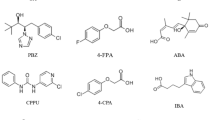Abstract
A radioimmunoassay for (+)-abscisic acid (ABA) was developed and applied to the analysis of free ABA in extracts of apple (Malus pumila Mill.) and sweet pepper (Capsicum annuum L.) leaves at various stages during extract purification. Conjugates of ABA, were quantified after alkaline hydrolysis. The validity of the radioimmunoassay was tested by comparison of immunoassay estimates of ABA at different levels of extract purity with high-pressure liquid chromatography (HPLC) and combined gas chromatography-mass spectrometry. The antiserum, raised against (+)-ABA, was almost equally sensitive to (-)-ABA. Serum cross-reactivity with the methyl ester of ABA was 160% and with the glycosyl ester of ABA was 34%. Cross-reactivity with protein-ABA conjugates was very slight for C′4-conjugated keyholelimpet haemocyanin, but about 1000% for C1-conjugated alkaline phosphatase. Other compounds tested showed extremely low or undetectable cross-reactivities. Further evidence for the specificity of the assay came from the agreement between the results using different assay methods for both apple and pepper extracts, and from the observation that the only zone of immunoreactivity on HPLC elution profiles corresponded with authentic (+)-ABA. The use of polyvinylpyrrolidone in the assay minimised interference by other substances in plant extracts. In pepper, free ABA levels increased rapidly during water stress and recovered to pre-stress levels within two days after rewatering. Levels of ABA conjugates were significantly lowr than free ABA in unstressed plants, and also increased rapidly with stress, although not to the same extent as free ABA, and did not recover as rapidly as did free ABA. In apple, levels of free ABA and of ABA conjugates both increased more than twofold over a two-week period of water stress. In contrast to pepper, however, immunoreactivity of the conjugate fraction was increased by hydrolysis, indicating that different ABA conjugates predominate in the two species.
Similar content being viewed by others
Abbreviations
- ABA:
-
abscisic acid
- GC-MS:
-
combined gas chromatography-mass spectrometry
- HPLC:
-
high-pressure liquid chromatography
- Me-ABA:
-
methyl ester of ABA
- PVP:
-
polyvinylpyrrolidone
- RIA:
-
radioimmunoassay
References
Daie, J., Wyse, R. (1982) Adaptation of the enzyme-linked immunosorbent assay (ELISA) to the quantitative analysis of abscisic acid. Anal. Biochem. 119, 365–371
Ernst, D., Schäfer, W., Westerhelt, D. (1983) Isolation and quantitation of isopentenyladenosine in an anise cell culture by single-ion monitoring, radioimmunoassay and bioassay. Planta 159, 215–221
Fuchs, Y., Mayak, S., Fuchs, S. (1972) Detection and quantitative determination of abscisic acid by immunological assay. Planta 103, 117–125
Goldschmidt, E.E., Goren, R., Even-Chen, Z., Bittner, S. (1973) Increase in free and bound abscisic acid during natural and ethylene-induced senescence of Citrus fruit peel. Plant Physiol. 51, 879–889
Hastings, N.A.J., Peacock, J.B. (1974) Statistical distributions. Butterworths, London
Milborrow, B.V. (1978) The stability of conjugated abscisic acid during wilting. J. Exp. Bot. 29, 1059–1066
Milborrow, B.V., Mallaby, R. (1975) Occurrence of methyl (+)-abscisate as an artefact of extraction. J. Exp. Bot. 26, 741–748
Neill, S.J., Horgan, R., Heald, J.K. (1983) Determination of the levels of abscisic acid-glucose ester in plants. Planta 157, 371–375
Pengelly, W.L., Bandurski, R.S., Schulze, A. (1981) Validation of a radioimmunoassay for indole-3-acetic acid using gas chromatography — selected ion monitoring — mass spectrometry. Plant Physiol. 68, 96–98
Walton, D., Dashek, W., Galston, E. (1979) A radioimmunoassay for abscisic acid. Planta 146, 139–145
Weiler, E.W. (1979) Radioimmunoassay for the determination of free and conjugated abscisic acid. Planta 144, 255–263
Weiler, E.W. (1980) Radioimmunoassay for the differential and direct analysis of free and conjugated abscisic acid in plant extracts. Planta 148, 262–272
Weiler, E.W. (1982a) Plant hormone immunoassay. Physiol. Plant. 54, 230–234
Weiler, E.W. (1982b) An enzyme-immunoassay for cis(+)-abscisic acid. Physiol. Plant. 54, 510–514
Wright, S.T.C. (1975) Seasonal changes in the levels of free and bound abscisic acid in blackcurrant (Ribes nigrum) buds and beech (Fagus sylvatica) buds. J. Exp. Bot. 26, 161–174
Zeevaart, J.A.D. (1980) Changes in the levels of abscisic acid and its metabolites in excised leaf blades of Xanthium strumarium during and after water stress. Plant Physiol. 66, 672–678
Zeevaart, J.A.D. (1983) Metabolism of abscisic acid and its regulation in Xanthium leaves during and after water stress. Plant Physiol. 71, 477–481
Author information
Authors and Affiliations
Rights and permissions
About this article
Cite this article
Rosher, P.H., Jones, H.G. & Hedden, P. Validation of a radioimmunoassay for (+)-abscisic acid in extracts of apple and sweet-pepper tissue using high-pressure liquid chromatography and combined gas chromatography-mass spectrometry. Planta 165, 91–99 (1985). https://doi.org/10.1007/BF00392216
Received:
Accepted:
Issue Date:
DOI: https://doi.org/10.1007/BF00392216




